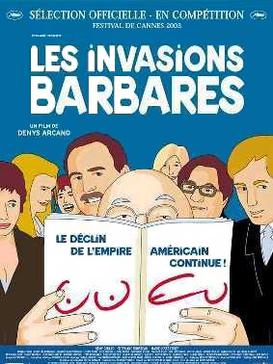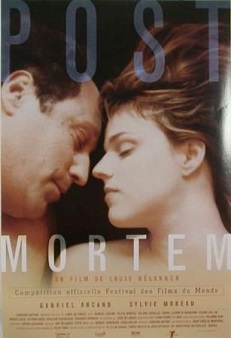
Cinema in Canada dates back to the earliest known display of film in Saint-Laurent, Quebec, in 1896. The film industry in Canada has been dominated by the United States, which has utilized Canada as a shooting location and to bypass British film quota laws, throughout its history. Canadian filmmakers, English and French, have been active in the development of cinema in the United States.

The Barbarian Invasions is a 2003 Canadian-French sex comedy-drama film written and directed by Denys Arcand and starring Rémy Girard, Stéphane Rousseau and Marie-Josée Croze. The film is a sequel to Arcand's 1986 film The Decline of the American Empire, continuing the story of the character Rémy, a womanizing history professor now terminally ill with cancer.
Claude Jutra was a Canadian actor, film director, and screenwriter.

Good Riddance is a 1980 French-language Canadian drama film. Directed by Francis Mankiewicz and written by Réjean Ducharme, the film concerns Manon, an unstable young girl who lives with her mother Michelle and her alcoholic and intellectually disabled uncle Ti-Guy.

Seducing Doctor Lewis is a 2003 Quebec comedy film and the first film directed by Jean-François Pouliot. The script was written by Ken Scott. It won the Audience Award at 2004 Sundance Film Festival. Starring in the movie are Raymond Bouchard, Benoît Brière, David Boutin and Lucie Laurier.

The Decline of the American Empire is a 1986 Canadian sex comedy-drama film directed by Denys Arcand and starring Rémy Girard, Pierre Curzi and Dorothée Berryman. The film follows a group of intellectual friends from the University of Montreal history department as they engage in a long dialogue about their sexual affairs, touching on issues of adultery, homosexuality, group sex, BDSM and prostitution. A number of characters associate self-indulgence with societal decline.

Frédéric Back was a Canadian artist and film director of short animated films. During a long career with Radio-Canada, the French-language service of the Canadian Broadcasting Corporation, he was nominated for four Academy Awards, winning two, for his 1981 film Crac and the 1987 film The Man Who Planted Trees.

Helmut Dantine was an Austrian-American actor who often played Nazis in thriller films of the 1940s. His best-known performances are perhaps the German pilot in Mrs. Miniver and the desperate Bulgarian refugee in Casablanca, who tries gambling to obtain travel visa money for himself and his wife. As his acting career waned, he turned to producing.
Michel Arcand is a Canadian film editor from Val-d'Or, Quebec. He is a three-time Genie Award winner for Best Editing.

Nicole Germain, C.M. was a Canadian actress in Quebec radio and film in the 1940s and 1950s and later as a journalist. In 1974, she was named a member of the Order of Canada.

Post Mortem is a 1999 Canadian drama film directed by Louis Bélanger. The film won two Genie Awards, including Best Actress for Moreau.

The 2nd Toronto International Film Festival (TIFF) took place in Toronto, Ontario, Canada between September 9 and September 18, 1977. Retrospective of Quebec cinema was introduced and also Greek cinema was emphasized. J.A. Martin Photographer directed by Jean Beaudin was selected as the opening film.
The Prix Iris for Best Film is an annual film award presented Québec Cinéma as part of its Prix Iris program, to honour the year's best film made within the Cinema of Quebec.
Q-Bec My Love is a Canadian film, directed by Jean Pierre Lefebvre and released in 1970. A satirical allegory for Quebec nationalism, the film is depicted in disconnected vignettes which portray the professional, sexual and romantic relationships of Q-Bec with her boss Peter Ottawa, her husband Jean-Baptiste Bilingue and her lover Sam Washington.
The 2nd Canadian Film Awards were presented on April 19, 1950 to honour achievements in Canadian film. The ceremony was hosted by Prime Minister Louis St. Laurent.
Saint Martyrs of the Damned is a Canadian drama film, directed by Robin Aubert and released in 2005. The film stars François Chénier as Flavien Juste, a tabloid reporter who writes about strange paranormal phenomena; when he is sent to the small Quebec town of Saints-Martyrs-des-Damnés to investigate a series of strange disappearances, his photographer colleague Armand disappears as well, but he finds the townspeople actively impeding his efforts to locate his friend.
Two Women in Gold is a Canadian sex comedy film, directed by Claude Fournier and released in 1970.
The Village Priest is a Canadian drama film, directed by Paul Gury and released in 1949. The film stars Ovila Légaré as a smalltown Roman Catholic priest whose skills as a spiritual and moral leader of the community are tested when Leblanc, a criminal fugitive originally from the town, returns home to see his estranged daughter Juliette on the eve of her wedding to Lionel Théberge.
A Man and His Sin is a Canadian drama film, directed by Paul Gury and released in 1949. Adapted from Claude-Henri Grignon's 1933 novel Un homme et son péché, the film stars Hector Charland as Séraphin Poudrier, the wealthy but miserly mayor of the village of Sainte-Adèle, Quebec, Nicole Germain as Donalda Laloge, a village resident who was given in marriage to Séraphin as payment for a family debt even though she is actually in love with her boyfriend Alexis Labranche, and Ovila Légaré as the village priest Antoine Labelle.
Séraphin is a Canadian drama film, directed by Paul Gury and released in 1950. A sequel to the 1949 film A Man and His Sin , which was an adaptation of the novel by Claude-Henri Grignon, the film tells the story of Séraphin Poudrier's family and community getting their revenge on him for his miserliness and lack of compassion amid the context of Antoine Labelle's drive to increase the settlement and development of the region.










